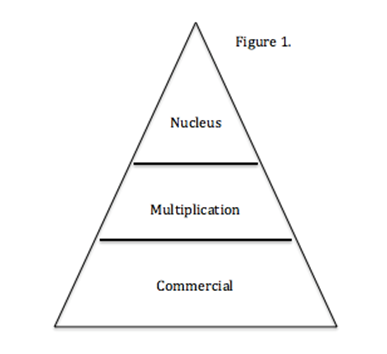



Utilizing commercial data to improve genetic response
Genetic improvement is achieved using pure breeds or lines at the nucleus, located at the top of the pyramid. This is the smallest sector of the pyramid. That genetic improvement is then disseminated down to the commercial sector where the final product is generally crossbred offspring.Genetic improvement in swine and its dissemination is commonly depicted as a pyramid (Figure 1).
There are a number of benefits to this system. At the nucleus level, the animals are raised in high health environments so that producers receive disease free breeding stock. Furthermore, high management at the nucleus ensures animals can express their genetic potential that the superior animals can be identified. Others include heterosis and breed complementarity. Heterosis is the improvement in offspring performance above what is expected based on the average of their parents as a result of crossing pure breeds. Breed complementarity is utilizing the strengths of individual breeds so that the offspring benefit from both parental strengths. An example is a Landrace x Yorkshire F1. Both breeds are maternally focused, but have different strengths such as litter size in Yorkshire and mothering ability in Landrace.
There are disadvantages to this structure as well. Commercial animals are required to perform in environments and management systems that are different from what their parents were selected in, which can result in performance of offspring that is different than what is expected. A quantitative measure of this is the correlation between crossbred and purebred performance when pure animals have offspring in both production systems. A correlation measures the association between two variables, such as growth of purebred offspring and growth of crossbred offspring when the sire is the same for all progeny. For example, if a sire’s genetic value based on the performance of his purebred offspring is the same based on the performance of his crossbred offspring, the correlation is 1. If the genetic value is not the same, the correlation is less than 1 and the sire will be ranked differently in the genetic evaluation (e.g. ranked 4th in the pure evaluation and ranked 30th in the crossbred evaluation). The closer the correlation is to 0, the more informative commercial data is in the genetic evaluation.
The above example is a common problem in the swine industry. The goal of genetic improvement is not to improve performance to maximize profitability of the pure animals, but to disseminate improvement to maximize profitability at the commercial level. Genesus has investigated the relationships between pure and crossbred performance for production traits and carcass and meat quality traits. These correlations for production traits (growth, fat depth, and loin depth) and carcass and meat quality traits (hot carcass weight, loin eye area, fat depth, loin depth, marbling, loin color, and loin pH) vary widely. With the exception of a couple of traits, these correlations were low and including crossbred data in the genetic evaluation would increase genetic progress at the commercial level.
Studies have shown that including commercial crossbred performance data in the purebred genetic evaluation system does improve genetic response, but this has primarily been studied using computer simulation (Wei and van der Werf, 1994, Bijma and van Arendonk, 1998). There are a number of challenges that must be overcome to properly implement this concept. The phenotypic data used in the genetic evaluation must be collected accurately and on individual animals, which is not common practice at the commercial level. Furthermore, detailed pedigrees must be recorded and connected to the purebred pedigree that is used in the evaluation. Again, this is not common practice. However, new technology (e.g. genomics) can help to overcome many of these issues. Individual performance and detailed pedigree information are still required, but genomics can assist with improving the accuracy of EBVs to better identify parents that will produce offspring that perform better at the commercial level.
Genesus’ goal is simple: Provide genetic materials, programs, and services that assist our customers in maximizing profitability. Genesus continually seeks out new technology and methods to achieve this goal. Genesus is collaborating with a commercial production system where detailed phenotypes are collected on a continual basis. In addition, these crossbred animals are genotyped and the information is included in our weekly genetic evaluation to increase the accuracy of the EBVs of our pure populations to select parents that will produce superior crossbred offspring, ultimately increasing profitability to our customers.
References:
Bigma P and van Arendonk JAM. 1998. Maximizing genetic gain for the sire line of a crossbreeding scheme utilizing both purebred and crossbred information. Animal Science. 66:529-542.
Wei M and van der Werf. 1994. Maximizing genetic response in crossbreds using both purebred and crossbred information. Animal Production. 59:401-413.










